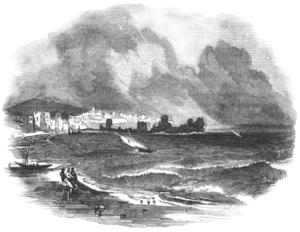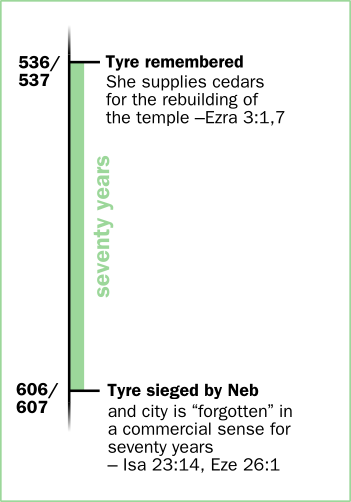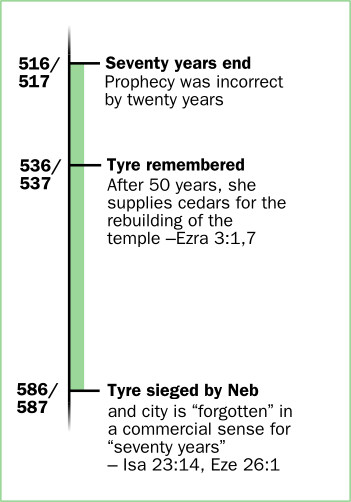The 70 year desolation of Jerusalem isn't the only Bible prophecy that failed according to the 587 chronology. There is another 70-year Bible prophecy that also supposedly failed – for Judah's enemy, Tyre.

Old line drawing of Tyre's ruined shoreline
Shortly after Jerusalem was destroyed, Ezekiel made the following prophecy in : “And it came about in the eleventh year... the word of Jehovah occurred to me, saying: “Son of man, for the reason that Tyre has said against Jerusalem, ‘Aha! She has been broken, the doors of the peoples! The trend will certainly be to me. I shall be filled–she has been devastated,’ therefore this is what the Sovereign Lord Jehovah has said, ‘Here I am against you, O Tyre, and I will bring up against you many nations, just as the sea brings up its waves. And they will certainly bring the walls of Tyre to ruin and tear down her towers, and I will scrape her dust away from her and make her a shining, bare surface of a crag.” –verses 1-4
The prophet pulls no punches telling us who will carry out such destruction. He continues saying, “Here I am bringing against Tyre Nebuchadrezzar the king of Babylon”. (verse 7) He describes the Babylonian army to come upon Tyre, “with horses and war chariots and cavalrymen and a congregation, even a multitudinous people... and he must make against you a siege wall and throw up against you a siege rampart and raise up against you a large shield; and the strike of his attack engine he will direct against your walls, and your towers he will pull down, with his swords.” –verses 7-9
If we move back to Isaiah, and look in chapter 23, the prophet there gives even more details of exactly what would happen when Tyre is attacked by Babylon. Speaking in the present-tense as if his prophecy is already happening he says, “Chaldeans. This is the people... They have erected their siege towers; they have stripped bare her dwelling towers; one has set her as a crumbling ruin. Howl, you ships of Tarshish, for your stronghold [Tyre] has been despoiled.” –verse 13
Now comes the important point. “And it must occur in that day that Tyre must be forgotten seventy years, the same as the days of one king. At the end of seventy years it will happen to Tyre as in the song of a prostitute: “Take a harp, go around the city, O forgotten prostitute. Do your best at playing on the strings; make your songs many, in order that you may be remembered.” –verses 14-16
So Tyre will not be destroyed by the Chaldeans (Babylonians) laying siege to her, but will simply cause her to be “forgotten” for “seventy years”. The prophet compares her to a forgotten prostitute who hasn't been hired. She needs to take a harp and sing songs to receive customers again (in ancient times prostitutes were distinguished by their singing in the streets at night to attract the attention of a client).
Isaiah continues, “And it must occur at the end of seventy years that Jehovah will turn his attention to Tyre, and she must return to her hire and commit prostitution with all the kingdoms of the earth upon the surface of the ground. And her profit and her hire must become something holy to Jehovah. It will not be stored up, nor be laid up, because her hire will come to be for those dwelling before Jehovah, for eating to satisfaction and for elegant covering.” –verses 17-18
When the seventy year period ends, Tyre's “profit” and “hire” will become “something holy to Jehovah”. This cryptic remark was fulfilled when the temple was rebuilt in 537 BCE. Ezra 3:7 tells us, “they proceeded to give money to the cutters and to the craftsmen, and eatables and drink and oil to the Sidonians and the Tyrians, to bring cedar timbers from Lebanon to the sea at Joppa, according to the permission granted by Cyrus the king of Persia to them.”
So from these prophecies we can discern these points:
- Tyre will not be destroyed by the Chaldeans, but be forgotten for 70 years, in a business sense and will not be hired. Like an unwanted prostitute, she shall have no customers. ()
- Nebuchadnezzar comes against Tyre sometime after Jerusalem was destroyed. ()
- When the 70 year period expires, Tyre shall restart her business, but give her profits to Jehovah's temple. (; )
First of all, let's consider this in the secular chronology. According to historians, Tyre came under siege by Babylon shortly after the destruction of Jerusalem. This would place it in either late 587 or early 586 BCE. The 70 year period would end 70 years later in 517 or 516 BCE.
However, Isaiah told us what would happen when the 70 period ends, that Tyre's profit would become “something holy to Jehovah”. This occurred in 537 or 536 BCE in the secular chronology when Tyre provided Cedar timbers for the temple of Jehovah.
This is a problem. That's only 50 years later when Tyre performed a holy work for Jehovah, not 70. Therefore, according to the secular chronology, the 70 year prophecy for Tyre failed – it was 20 years out —See charts one and two for the chronology.
Now, in contrast, let's apply the Bible's 607-based chronology. If we assume that Tyre was sieged by Babylon shortly after Jerusalem was destroyed, seeing as the last prophecy against her took place in that year (), and secular chronology agrees with this point, then Babylon attacked Tyre in late 607 or early 606 BCE.
Counting 70 years hence, we come to 537 BCE or 536 BCE – the exact year the Bible says Tyre supplied Cedar timbers for the holy temple of Jehovah! The 70 year prophecy is a success!
Only the 607-based Bible chronology allows this prophecy to be fulfilled. The chronology of secular historians, of the Churches, and of the apostates that promote it, all make the 70-year prophecy a joke. According to 587-based secular chronology, Tyre was supplying cedars and free of the Babylonian yoke just 50 years later, not 70! Who do you think is wrong? The secular chronology, or the Bible?
- The 70 years for Tyre began after Jerusalem was destroyed.
- For 70 years Tyre was not hired in a commercial sense.
- The period ended when Tyre supplied Cedars for the Temple of Jehovah, exactly 70 years later.
- Only the 607-based chronology allows for this period. The secular chronology does not.

